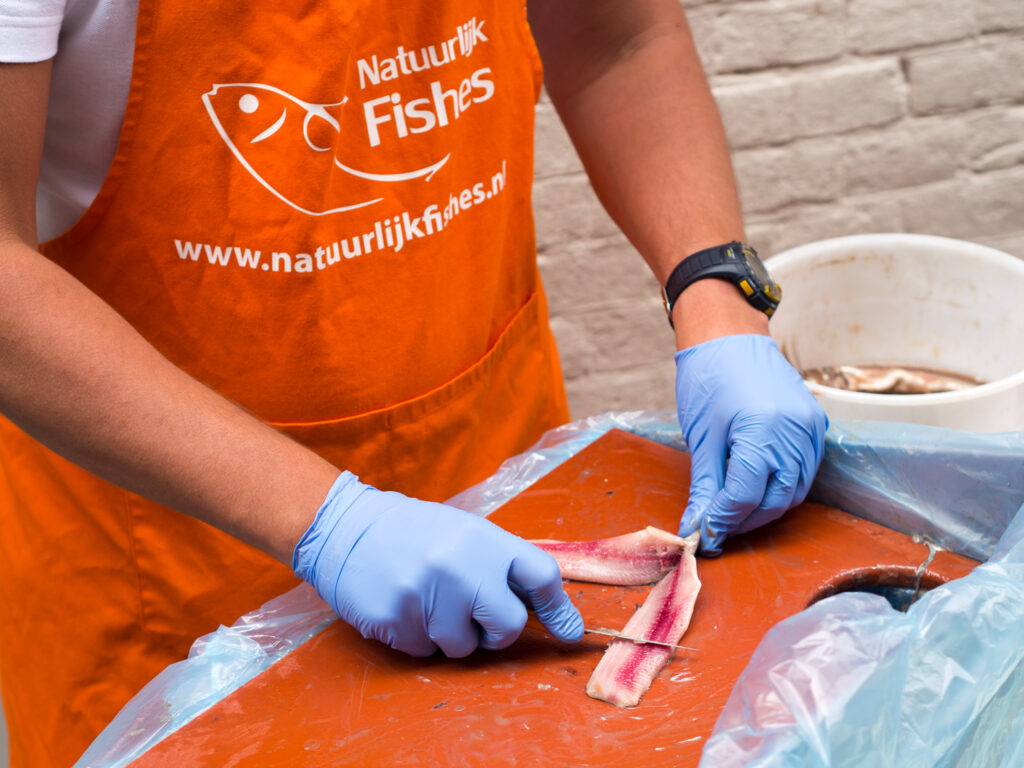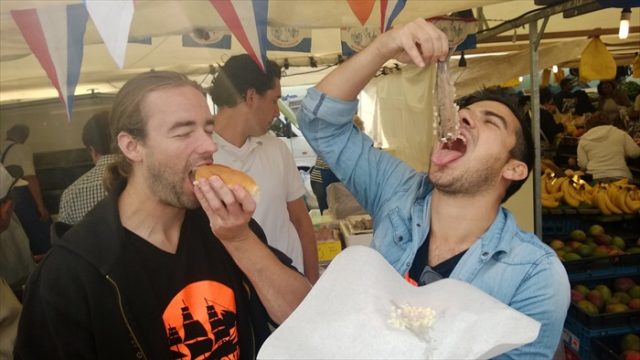The large-scale herring fishing in the Netherlands started during the Golden Age. Since then, Dutch herring and the ‘Hollandse Nieuwe’ have become a delicacy with culinary fans all over the world. 🐟
The herring fleets of the 15th century also gave birth to the all-powerful Dutch merchant navy.
To the Dutch, herring had become an indispensable source of proteins and nutrients, thanks to which the population could grow (really, really tall).
Herring in the Netherlands: the basics
Eating herring in the Netherlands is a Dutch tradition. Lots of tourists find it exciting to buy herring for the first time, grab the whole fish by its tail, and let it slide down their throats in typical Dutch fashion.
The Netherlands and herring are inextricably linked, and no fish is more Dutch than the popular so-called Hollandse Nieuwe!
READ MORE | The Dutch ‘fish doorbell’ has been pressed 150,000 times so far this year
A herring is a small, slender, silvery fish. About a quarter of its body weight can consist of fat. Herrings can become eight to ten years old.
After two to three years, the herring is mature and about twenty centimetres long. For a while, the herring was heavily overfished and almost on the brink of extinction.
Thankfully, the species is thriving again due to global quotas restricting the number of herring fishermen are allowed to harvest at a time.
Where exactly does the herring come from?
Herring comes from the eastern part of the North Sea, and most herring can be found in the waters around Norway and Denmark.
Some can also be found a little bit to the eastern part of the North Sea, near Scotland.

Almost all the herring eaten in the Netherlands is caught by Danish and Norwegian companies, while Dutch companies with factories in Skagen, Denmark, prepare them and bring them back to the Netherlands to sell.
The opening of the herring season in the Netherlands
The traditional auction of the first keg of herring takes place in Scheveningen every year, with proceeds going to charity. In 2009, a record revenue of more than €66,000 was gained from the auction.
A day after the auction, the herring season officially starts, and the following Saturday is called Flags Day.
Traditionally, the auction only involves the sale of Dutch herring called Hollandse Nieuwe. 👇
What is Hollandse Nieuwe Herring?
The name can sometimes be confusing. It raises the question: when is a herring both Dutch (Hollandse) and new (Nieuwe)?
Well, herring may only be called Hollandse Nieuwe if it has a certain percentage of fat — at least 16% — and has been cleaned the right way.
It is typically caught between May and September and can be quite scarce in the winter months.
The name maatje or maatjes herring is derived from virgin herring. This means that the herring caught does not yet contain a roe and may not be ready for the Hollandse Nieuwe name.
Vlaggetjesdag (Flags Day) in the Netherlands
Vlaggetjesdag (Flags Day) has a long and interesting history, though it has only had its name since 1947.
According to history books, there was a ban on catching too many herrings from the sea in the 18th century. Due to the ban, fishermen had to focus on other species such as the flatfish.
Only a limited number of fishermen were allowed to sail out to catch the herring — usually, only about 10 boats were allowed to leave every day.

The first herring caught by any of the 10 boats was traditionally awarded to a high-ranking person (like a mayor, or even stadtholder). The tradition started because Stadtholder Willem V was present on a regular basis to check the departure of the boats.
The fishermen enjoyed the statesman’s official presence and decorated their villages with flags to welcome him (hence Flags Day!).
An official Vlaggetjesdag Committee was established in 1950 and has been in charge of all the festivities surrounding Flags Day ever since.
Preparing herring or ‘gibbing’
Gibbing is the process of preparing salt herring, which en-tail-s (get it 😉) the removal of the gills and part of the gullet with a specially designed knife.
However, the liver and pancreas remain untouched because they release enzymes essential for flavour.
Gibbing also involves the removal of the heart and the intestines, after which the fish is stored in a wooden barrel with salt. In this way, the herring can be stored for long periods and transported more easily.

Haringhappen in the Netherlands
Haringhappen is a Dutch tradition that was borrowed from the Catholic faith. During Lent, Catholics are prohibited from eating meat so Dutch Catholics ate herring to usher in the fasting period after the carnival.
These days, Haringhappen is a regular part of the festivities surrounding carnival in the Netherlands.
The Wednesday after carnival is officially called Ash Wednesday and has traditionally been a Catholic event where Christians get an ash cross on their forehead — as a sign of penance and a moment of contemplation.
After getting their ash crosses, Dutch locals usually tuck into some herring at home. Thus began the tradition of eating herring on Ash Wednesday and also during Lent.
How to eat herring in the Netherlands
For tourists coming to the Netherlands, especially for the first time, eating herring is something that must be done the right way to avoid judgmental looks from Dutch locals.
@dutchreview Did somebody say lekker?! #dutchfood #dutchmemes #dutchlife #expatlife #expatsinthenetherlands #thenetherlands #dutchreview #meme #memecut ♬ original sound – DutchReview
So without further ado: it’s customary to grab a salty herring by the tail and then let it slide down your throat.
Often this is done with onions to somewhat neutralise the strong taste of the herring. Tourists usually find it a disgusting way of eating fish, and there are lots of Dutch folks who don’t like it either.
READ MORE | The complete guide to eating herring in the Netherlands (without traumatising yourself!)
But you don’t necessarily have to eat herring raw. It can also be eaten fried or smoked.

Some fun facts about the Dutch herring
- About 50 billion herring swim in the North Sea every year.
- At a certain point during the Dutch Golden Age, the Netherlands had 80% of the herring market and made so much money from the herring trade that they were easily among the top three richest countries in Europe.
- You can use your phone to judge how fresh your herring is. The app “How fresh is your fish?” can be used to determine and judge the freshness of 15 fish species, herring included. The app is free to download for iPhone and Android phones.
- The closing of the North Sea to herring fishing in 1977 forced Dutch fishermen and herring buyers to move to some Scandinavian countries permanently. Denmark turned out to be the most suitable place for them.
- More than 80% of the herring eaten in the Netherlands isn’t caught here. Only two ships in the Netherlands are actively catching herring in Scheveningen.
- You can only eat herring during the herring season and in the Netherlands, the season starts in the month of June. In Scandinavia, that is usually in the period from May to July.
- Eating herring is healthy because it’s a fatty fish. Herring contains omega-3 fatty acids, which act as protection against heart diseases.
So whether you live in the Netherlands or you’re just visiting, don’t forget to take part in the popular Haringhappen.
But whatever you do, please don’t eat herring with cutlery. Pick it up by the tail and slide it down your throat like a true Dutchie!
Have you ever tried eating herring in the Netherlands? Did you like it? Tell us in the comments!





Being Dutch, living in Australia, there is nothing nicer than a salted herring…with finely diced onions.
Roll mops are nice also.
Being half Dutch, living in the Netherlands, there is nothing nicer than Hollandse Nieuwe with Soya/ketjap sauce or with pepper.
Just had breakfast of Scottish kipper (smoked herring) here in Northland, NZ. YUM!!!
Good article however a ridiculous way of describing how a Dutchman eats a herring. “Sliding it down their throat.” A seagull does that. A Dutchman chews before swallowing his food.
Its disgusting indeed! But being a Dutchman….one herring has more omega3 then a 20 euro pot off omega3 pills,cheers! And i dont chew my food,saves my teeth!
I’m italian, born and raised in Sardinia, where most of the the people are sea food lovers, and surely I am no exception! As such I love herring, specifically Dutch herring, whenever possible I route my flights through Amsterdam to enjoy some delicious herrings, at the airport!
I want enjoy
I love herring! Only I never can find it in the United States. The only way I find it is pickled in wine sauce. Which is not to bad either. But no fresh once’s
I worked in Amsterdam for a few months 40 years ago and discovered a Brown Bar on a corner of Plantage Middenlaan.
My first Nieuwe Herring became a favourite and I’d have it every other day.
Back in the U.K. I could only find rollmop soused in small tubs which weren’t the same and now trying to find fresh herring near me quite impossible. I’d like to buy a dozen to put in my smoker.
However, a trip into my local LIDL last week I found jars of Polish pickled herring, still not the raw fresh, but bought 4 jars anyway.
Tomorrow I’ll be back and buy up however many that I can find 🙏
Same for me. I discovered Dutch herrings 30 years ago visiting Amsterdam on my own. A man I was speaking with suggested me to try the local favourites: herrings and smoked eels. Love that fish but I never had it that way. Now living in London I gorge on Lidl herrings whenever I found them lol
One doesn’t “let it slide down your throat”. One simply takes bites of the hand held herring.
The majority of Dutch people eat herring cut in bite size pieces with chopped onions and eaten with a toothpick.